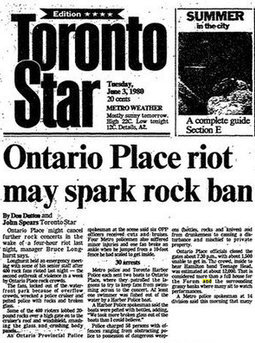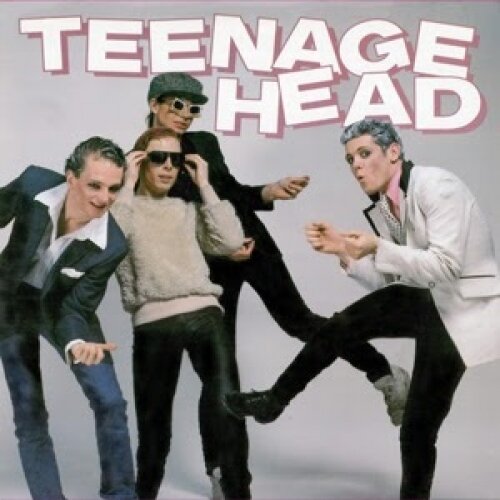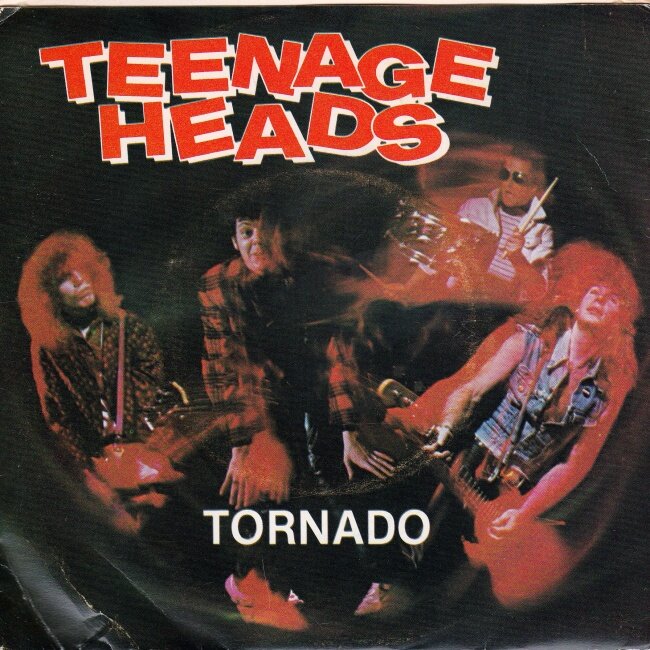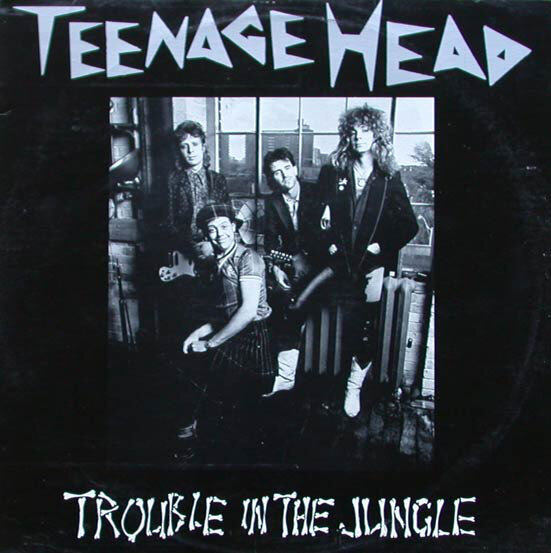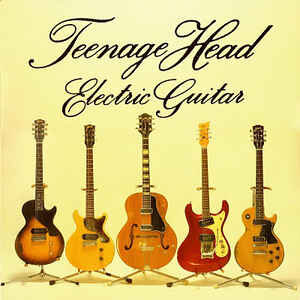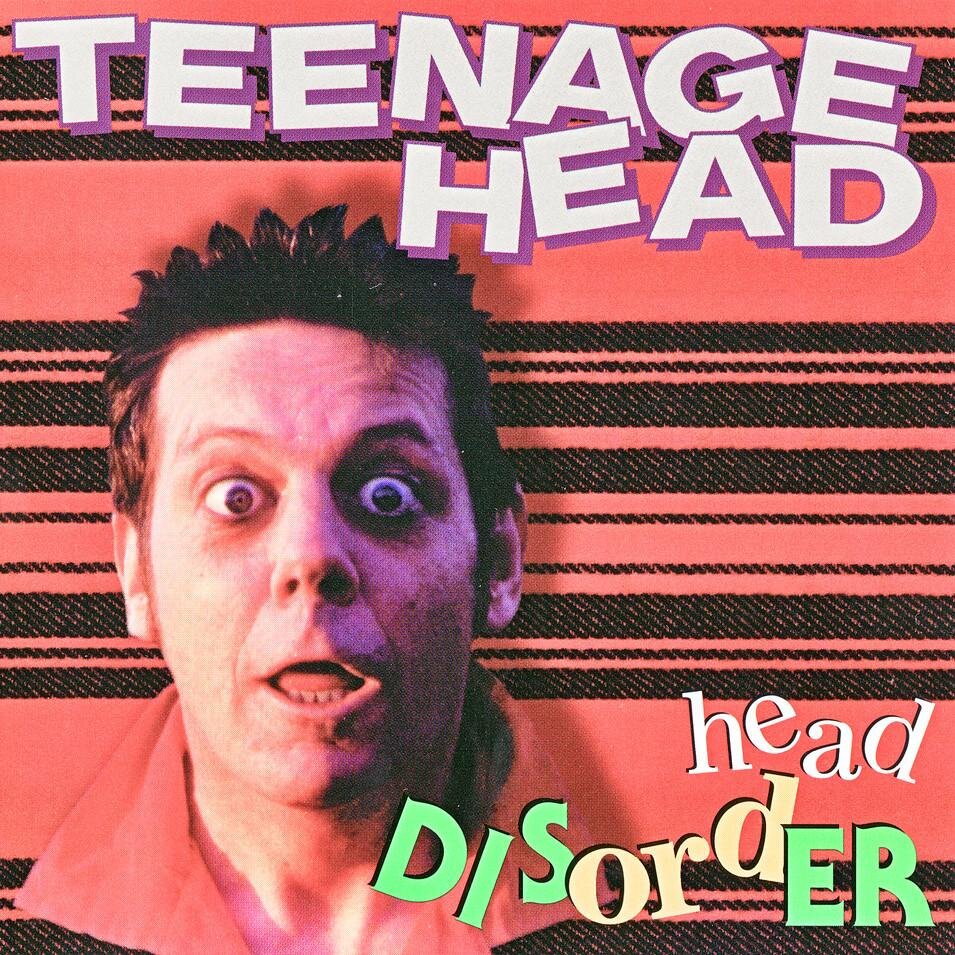Frantic City: A Retrospective of Teenage Head
Click below on the streaming service of your choice to listen to the playlist as you read along.
From a Canadian perspective – certainly for those in Ontario –Teenage Head has been one of the country’s most notorious, iconic, and cherished bands. Few bands have had as loyal, fervent, and persistent a fan base as this act from Hamilton. However, aside from one or two shows, they were a band that never raised its profile above bars and high school gyms. And if you’re from outside Canada and have heard of this band, then hats off to you, because you have been blessed to enjoy their fun and frenetic output. The story of Teenage Head has been one of missed chances, fleeting success, and a vexing career of ups and downs.
I was inspired to write this profile after recently watching a new documentary on Teenage Head, currently available on public television in Ontario. While the film focuses as much on their recent incarnation, and particularly on the mental health issues around band leader, Gord Lewis, it also suitably traces their early days and heyday as, potentially, one of Canada’s biggest music acts. I also caught them for the first time in a club in Toronto a couple years ago, surrounded by friends who had been seeing this band since their early days and was seeing them for the umpteenth time. These occasions reminded, and reinforced, that this a band deserving of recognition, if only for their story of adversity and loyal following.
Gord Lewis (guitar) toyed with the idea of a band since he joined high school. He was inspired by hearing the rehearsals of a band in the basement of friend and nascent drummer, Nick Stipanitz’s house, whose older brother, Paul, was in said band. Lewis’ band started to take shape in 1975 within the halls of Westdale High School in Hamilton, a city at the end of Lake Ontario and, once upon a time, the heartland of industry and steel production in Canada. Lewis pulled together a group with Steve Park on bass and an older, cooler, classmate on drums, Frank Kerr. Scoring a gig at a local street BBQ in August 1975, the band recruited friend Dave Desroches on vocals.
Desroches went on to form his own band, The Shakers, and Park moved to rhythm guitar, opening a slot for another classmate, Steve Marshall (who performed as Steve Mahon), to join on bass. Stipanitz joined on drums when it was discovered that Frankie could sing and was a much better presence up front. In October, the new band, dubbed Teenage Head after the 1971 song and album by the Flamin’ Groovies (in which Gord had seen an ad for it in a magazine but hadn’t actually heard the song or album, but knew it was a great name for a band), played their first show at the Westdale cafeteria.
The band started out with a decidedly glam look. This photo was considered over for an album cover. L to R: Stipanitz, Mahon, Venom, & Lewis.
Inspired by the music and look of The New York Dolls, the band’s glam style was an odd fit for the blue-collar climate of Hamilton. Their long hair and tight jeans fit the rock look of the times, but the lipstick and energy of the music was a step outside the local norms. Steve Park left to join another band, Simply Saucer, leaving Teenage Head as a quartet of Lewis, Mahon, Stipanitz, and Kerr, who took on the fabled stage name, Frankie Venom.
The band played a hard-driving mix of late ‘50s rock ‘n’ roll and rockabilly and ‘60s garage rock, which in 1976 was becoming known as punk, thanks to the likes of The Ramones, the most infamous band that shared the sounds in which Teenage Head was exploring. The comparison would be lasting.
Teenage Head forged their reputation within the punk scene in nearby Toronto. Their frantic live show, thanks to Venom’s performances of wild abandon, built a loyal following leading to a signing with Epic Records. Over the course of 1978 they released their first two singles, starting in May with, “Picture My Face,” an impossibly catchy, edgy, melodic, raw tune. Next came “Top Down,” an unabashed punk song, ripping at a ferocious pace. The singles didn’t chart, but the reputation of Teenage Head was launched.
That summer fledgling promotors, The Garys (Gary Topp and Gary Cormier), were given a run of shows at the legendary club in Toronto on Queen St. West, The Horseshoe Tavern. They helped give exposure to Toronto’s growing punk scene, but the run was short lived, and they planned a blowout finale, to be filmed by Colin Brunton. Dubbed ‘the last punk rock concert,’ it was cheekily titled ‘The Last Pogo,’ a nod to the final show of seminal Canadian rock act, The Band, of which the film and album, The Last Waltz, had been issued earlier that year. Several bands performed, including another notable Toronto punk band, The Viletones, and was headlined by Teenage Head. The end of the show resulted in a bit of bedlam, creating a riot-like scene very unlike the staid Toronto disposition.
Teenage Head, the band’s debut LP, was released in March 1979 and offered up eight more rippin’ tracks to the two singles, mixing power pop, punk, and an irreverence unlike anything else on the Canadian music scene.
Teenage Head’s legacy was built on their second album, Frantic City. It was the perfect distillation of their talent, the mix of their influences, and an impeccable compilation of brilliantly catchy, fun, and rocking tunes. Led by the first single, “Somethin’ on My Mind,” its smooth pop melody and sax punctuations may have surprised fans of the first album, but it was undeniable as a throwback rock ‘n’ roll song. Released in 1980, it had something for both the punkers, whose scene was ebbing away, and those more attuned to the new wave offerings of the new decade. The single brought the band its first chart attention, cracking the top forty in the Canadian singles chart.
Steve Mahon, Frankie Venom, and Gord Lewis
If any rockers were thinking of turning away after the smoother sounds of “Somethin’ on My Mind,” the next single, “Let’s Shake,” returned the band to their edgy, retro-rock sound in exemplary fashion. Its mix of acoustic and electric guitars with Frankie’s rockabilly-tinged vocals were the perfect recipe to set anyone’s feet moving. It charted, but not highly, in Canada.
Frantic City was released via Attic Records in 1980 and brought more of the band’s joyful, driving sound. There were so many hooks it was hard to pick a standout track, with each offering a different angle of appeal. Frantic City easily ranks among the best albums ever issued by a Canadian band. However, despite heavy airplay on radio, the album only came within a hair of the top forty in the Canadian album chart.
Rock music was indeed banned from Ontario Place for several years after Teenage Heads’ show
In June, Teenage Head was booked to play the Ontario Place Forum, a circular, outdoor amphitheatre with a revolving stage located in an amusement park along Toronto’s lake shore. During the summer, bands were booked to the venue to draw people to the park, with entry to the show included with park admission. Paired with another popular local act, the Segarini Band, it became clear there were more attendees than what the venue, with a capacity of 16,000, could hold. As the show progressed, entrance to the Forum was closed off, leaving many eager fans shut out. Tempers flared and people took it out on the park, damaging property, swimming in the lake to try and get around the fences, and fighting with security and the police. Once again, stolid Toronto was shaken and notoriety for this band that had caused two riots in a year grew, propelling Frantic City to greater success than it was already enjoying.
In August, they opened the Heatwave festival an hour away from Toronto. Despite a line-up that included The B-52s, Talking Heads, The Pretenders, Elvis Costello and The Attractions, and originally The Clash (they didn’t perform after being held up at the border), a huge crowd still showed up early in the day to pay homage to their local heroes, Teenage Head. It was the band’s biggest show and unbeknownst at the time, the pinnacle of their career.
Looking to parlay the success of Frantic City into a US record deal, Attic Records set up Teenage Head for a series of showcase shows in New York. A couple days before, Gord Lewis was seriously injured in a car accident and the shows were cancelled. The band was also held from touring for months, though recruited David Bendeth to fill in for a spell.
Much of the next album had been recorded at the time of the accident, and once Lewis was recovered it was completed and released. Some Kinda Fun didn’t come close to the quality of Frantic City. It was a solid album but didn’t have the same irresistible mix of hooks and charm. Also, the sounds of the LP lacked the breadth of variety the second album had provided. Fans of the sound lapped it up, but there wasn’t sufficient growth in the band’s audience to propel them further. Their following aided them in playing successful small venues shows across the country, beloved as much in the smaller locales as in the big cities. The LP’s title track was the lead single and reached #23 in the Canadian singles chart, their highest achievement of their career, and the album cracked the top twenty.
The album’s success encouraged the label MCA to take up the band’s cause and try for another push into the US market. The band recorded an EP, Tornado, for its first international release. Concerned about American reaction to the band’s cheeky moniker, the EP was released in 1983 under the band name, Teenage Heads (Mahon also started going by his real name, Marshall, from that point on). The label also changed the band’s sound, producing a typical ‘80s pop sound infused with sax and smooth melodies, especially on the lead track, “Don’t Cage Me In.” The edgy guitars and frenetic energy were mostly gone, or channeled into formulaic pop structures, such as on the title track, which was released as a single. It barely reached the top forty in Canada and went nowhere in the US. Despite the success of acts like The Stray Cats, interest in punk and rockabilly was lacking in 1983, with R&B, heavy metal, and new wave influenced pop dominating the US charts. Teenage Head would not gain the interest of a major label nor achieve chart success again.
It was three years before the fourth LP, Trouble in the Jungle, was released in 1986. Stipanitz played on the LP but was listed as an additional musician rather than a member of the band, showing the seams were coming apart. Mark Lockerbie moved in as the new drummer after the album’s recording. Venom’s increasing problems with drinking, drugs and erratic behaviour were challenging the band’s viability. The album’s lack of success propelled the fracture, with Frankie Venom leaving in 1987 to form new bands, the first being The Vipers and then later, The Blue Angels.
Dave Desroches (‘Dave Rave’), once their first vocalist and a guest on the prior album, came in to handle the vocals. The 1988 LP, Electric Guitar, was therefore recorded with only Marshall and Lewis from the original line-up. Jack Pedler was now on the kit and fellow Hamiltonian Daniel Lanois contributed on guitar. The album, despite offering a strong batch of songs, failed to restore the band’s popularity.
Desroches left soon after the album to form his own band, The Dave Rave Conspiracy (followed later by a folk-rock act, Agnelli & Rave), and Venom and Stipanitz returned to the line-up, playing a reunion show in 1988 at the Toronto club, Rock and Roll Heaven. Nick once again left and the band went into hiatus, facing an uncertain future. In 1995, a line-up of Lewis, Marshall, Venom, and Lockerbie toured and then recorded an album in 1996, Head Disorder. This was the last album of original material released by Teenage Head.
In 2003, the original trio of Lewis, Venom, and Marshall re-recorded many of their songs with drummer Marky Ramone, sanctifying the spiritual relationship they’d had with The Ramones since Teenage Head’s inception. The album, Teenage Head with Marky Ramone, wasn’t released until 2008.
Despite the lack of new material, Teenage Head continued to play shows but increasingly less so as Venom couldn’t be relied on due to his drinking. In October 2008, Frankie passed away due to throat cancer.
Teenage Head today: Dave Desroches, Gene Champagne, Steve Marshall, & Gord Lewis
Teenage Head has persevered since the death of their fabled singer. Pete MacAuley stepped in as the band’s new singer and was replaced in 2016 once again by Desroches. Jack Pedler, due to illness, was replaced on drums by Gene Champagne. After discovering a trove of master tapes of the band’s recordings, Warner issued a compilation in 2017, Fun Comes Fast. The band resumed touring to promote the release, now having to overcome Lewis’ challenges with depression and the prospect that he may not show up for performances.
Though their music largely remained in the same sonic environment for their whole career, Teenage Head were always dependable to provide energy, plenty of hooks, and fun. They are an act that has inspired a book, Gods of the Hammer, and now a documentary. Yet despite such attention and national success of their first few albums, they were never able to break outside Canada’s borders or elevate their following beyond those that could fill bars, gymnasiums, and small halls across the country. But when they did, they were met with an enthusiasm few artists in their country have inspired.
Update (Feb 2025): The tragic side of Teenage Head’s story added another chapter when, on August 7, 2022, Gord Lewis was found murdered in his home. Jon, his son, was charged but eventually found not criminally responsible due to his mental state. He suffered from schizoaffective disorder and had been spiralling into a delusional state in the months prior to the murder, spending several stints at the hospital for treatment.
The loss of Lewis has left Teenage Head with only Steve Marshall and Nick Stipanitz as the remaining living members of the band’s original line-up, though Nick has not participated in the band since 1988. The band has continued to play shows since Lewis’ death, now as a trio of Marshall, Desroches, and Champagne.
The Playlist - song \ album (year)
Top Down \ Teenage Head (1979)
Picture My Face \ Teenage Head (1979)
Lucy Potato \ Teenage Head (1979)
Curtain Jumper \ Teenage Head (1979)
You’re Tearin’ Me Apart \ Teenage Head (1979)
Somethin’ on My Mind \ Frantic City (1980)
Total Love \ Frantic City (1980)
Let’s Shake \ Frantic City (1980)
Infected \ Frantic City (1980)
Take It \ Frantic City (1980)
Disgusteen \ Frantic City (1980)
Shag Shake \ Some Kinda Fun (1982)
Fist to Face \ Some Kinda Fun (1982)
Don’t Toy with Me \ Some Kinda Fun (1982)
Let It Show \ Some Kinda Fun (1982)
Don’t Cage Me In \ Tornado EP (1983)
Tornado \ Tornado EP (1983)
Frantic Romantic \ Trouble in the Jungle (1986)
Save Your Love \ Trouble in the Jungle (1986)
Parasite \ Trouble in the Jungle (1986)
Teenage Doll \ Electric Guitar (1988)
Everybody Needs Somebody \ Electric Guitar (1988)
Walkin’ Alone \ Head Disorder (1996)
Seen It and Done It \ Head Disorder (1996)
First Time \ Head Disorder (1996)







